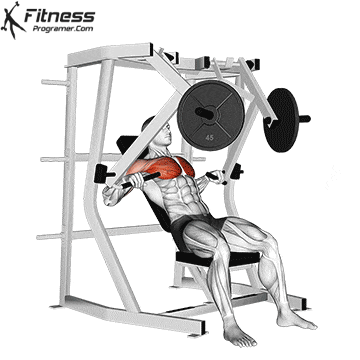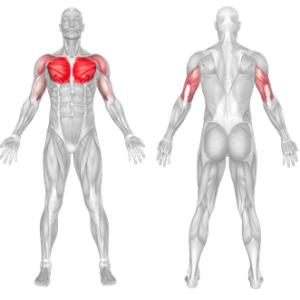Decline Chest Press Machine Overview
The Decline Chest Press Machine is a strength-training exercise that targets the lower portion of the pectoralis major. This machine-based movement mimics the biomechanics of a decline bench press but provides greater stability and controlled resistance. Its guided motion makes it ideal for both beginners and advanced lifters aiming to safely build strength and muscle mass.
How To Perform:

Setup
- Adjust the seat so that the handles are at chest level when seated.
- Sit on the machine with your back firmly against the backrest and feet flat on the floor.
- Grip the handles with a neutral or overhand grip, depending on the machine’s design.
Execution
- Starting Position:
- Hold the handles with your arms extended but elbows slightly bent to avoid locking out.
- Engage your core and keep your shoulders down and back.
- Lowering Phase:
- Slowly bring the handles toward your chest, maintaining control and keeping your elbows at a natural angle (not flared).
- Pressing Phase:
- Push the handles back to the starting position by extending your arms, squeezing your chest at the top of the movement.
- Repeat: Perform for the desired number of repetitions, maintaining proper form throughout.
Tips for Maximum Effectiveness
- Focus on Muscle Contraction: Squeeze your chest at the top of each press for maximum activation.
- Control the Negative: Lower the handles slowly to enhance time under tension and stimulate greater muscle growth.
- Combine with Other Chest Exercises: Pair with flat and incline pressing movements to achieve comprehensive chest development.
- Adjust Grip: Experiment with different grips (neutral or overhand) to slightly vary muscle activation.
- Breathe Properly: Inhale as you lower the handles and exhale as you push them back to the starting position.
Common Mistakes to Avoid
- Arching the Back: Keep your back firmly pressed against the backrest to prevent strain on your lower back.
- Locking Out Elbows: Avoid fully locking out your elbows at the top to maintain tension on the chest muscles.
- Incorrect Seat Height: Ensure the handles are aligned with your chest to optimize muscle activation and prevent awkward movements.
- Rushing the Movement: Perform the exercise slowly and with control to maximize muscle engagement and reduce the risk of injury.
- Overloading the Machine: Use a manageable weight to maintain proper form and avoid relying on momentum.
Benefits of the Decline Chest Press Machine
- Lower Chest Focus
- Specifically targets the lower portion of the chest, helping create a fuller, well-defined chest.
- Controlled Resistance
- The machine’s guided motion eliminates the need for balancing weights, reducing the risk of improper form or injury.
- Joint-Friendly Option
- Reduces stress on the shoulders and wrists compared to free-weight exercises, making it suitable for individuals with joint concerns.
- Muscle Isolation
- Allows for focused activation of the chest muscles with minimal assistance from secondary muscles.
- Progressive Overload
- Easy to adjust resistance, enabling gradual increases in weight for consistent strength and muscle growth.
- Accessibility
- Suitable for all fitness levels, from beginners learning proper form to advanced lifters aiming for precise muscle targeting.
Muscles Worked

